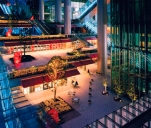Architecture of the Period

At present, one of the most pressing themes in architecture worldwide nowadays is sustainability. The architects are tasked to come up with creative solutions to design buildings which consume less energy, emit less harmful gasses, last longer, and can adapt to changes in the future.
Ecological standard
After the Kyoto Protocol in 1997, nations around the world announced their CO2 reduction target. Russia and Japan share the same target of reducing 25% compared to 1990 levels, EU set a range target between 20% and 30%, while China set a 40% to 45% cut as per 2005 levels. These are ambitious targets and require a significant effort on public and private sectors to achieve them. According to statistics in Japan, 54 % consumption will come from Building and Transport Sector this year.
This demonstrates the very important role architecture can play in reducing energy consumption. In recent years, the architectural design industry witnessed emergence of new green rating certification systems. Japan has developed the CASBEE which stands for Comprehensive Assessment System for Building Environmental Efficiency, placing a lot of emphasis on energy efficiency and reduction of the heat island impact, while US developed the LEED system which stands for Leadership in Energy and Environmental Design.
It is a thirdparty certification program and widely accepted benchmark for the design, construction and operation of highperformance green buildings. It gives building owners and operators the tools they need to have an immediate and measurable impact on their buildings’ performance. LEED promotes a whole-building approach to sustainability by recognizing performance in five key areas of human and environmental health: sustainable site development, water savings, energy efficiency, materials selection and indoor environmental quality.
BREEAM (BRE Environmental Assessment Method) is the environmental assessment method for buildings in UK. It sets the standard for best practice in sustainable design and a measure used to describe a building’s environmental performance ESTIDAMA is a rating system established by Environmental Agency in Abu Dhabi, is tailored for Middle east and based on four pillars, environmental, economic, social and culture. It places more emphasis on water conservation which is scarce in the arid climate.
In Russia there is no de facto rating system but the Russian Green Building Council has been established and is active now, and Russia may develop its own standard in the near future. The evolution of green buildings history in Japan goes back to oil shocks in seventies. Japan relies heavily on importing oil to drive its industries. The two oil shocks have forced Japan to rationalize its energy consumption strategies. This triggered emergence of new innovative technologies to conserve energy.
Another serious issue was the environmental pollution which caused several national disasters. Since then the government has revised the environmental policies, and now Japan maintains the highest and strictest policies. The technologies witnessed a gradual evolution starting from elemental technologies, which later witnessed implementation in public and high end headquarters, followed by larger implementation on commercial scale.
The rule of thumb in Japan is that with 10% of additional investment it is possible to achieve 40% in energy saving with a payback period of 5 to 10 years. Updated saving rates ensured by innovative technologies offer decrease energy consumption by 60% in comparison with conventional buildings.
There are numerous means of energy saving technologies which can be integrated into a high rise, such as Sunlight Scooper to introduce natural sunlight from rooftop via atrium; photovoltaic panels installed at rooftop contribute to less usage of fossil energy; Solar Shading - a unique façade equipped with externally mounted tilting louvers which reduces heat and control glare, while allowing daylight; Mirror Duct – a device which allows to reflect and introduce natural light to basement or deep inside the building; Dry Mist Cooling cools exterior space where thermal comfort is required with minimum energy; Cool Pond – a technique to store cool air at nighttime which reduces cooling load at daytime; high efficient Chiller and Thermal Storage – dedicated chillers operate at nighttime with high efficiency stored to building mass for daytime use; Light shelf is also a unique façade design which functions as light shelf to reflect and introduce daylight into inner space; Task & Ambient Lighting and Cooling allows end users to control overall energy saving; Cool Trench – which pre cools air with geothermal energy at lower levels of the buildings. This is a brief synopsis of energy saving features for a project in GCC region.
Full version you can download here
 Text by Fadi Jabri, General Manager of Nikken Sekkei Dubai office
Text by Fadi Jabri, General Manager of Nikken Sekkei Dubai office


